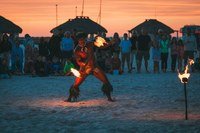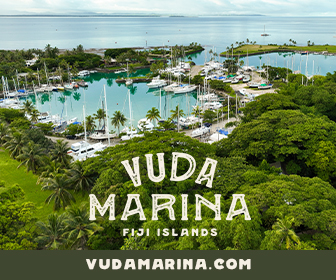Tips and Comments for a Visit to Western Samoa
Robert Burn provides an account of his time in Western Samoa, with tips to help other cruisers navigate the entry process with ease.
Published 6 years ago


- Fire Dance by Alex Perez on Unsplash
Apia
From a cruising perspective, Western Samoa is often the first practical landfall when heading west from French Polynesia. While some yachts elect to stretch their itinerary by stopping at Rarotonga or Suvarov Islands, allowing them a mid-point stopover as well as a better sailing angle, I bypassed these islands having visited in the past. I chose instead to head directly to Apia in Western Samoa, giving the charmless Pago Pago in American Samoa a miss. The following is a list of recommendations to make your welcome into Apia hassle-free.
Marina
The Apia Marina is amiably managed by young Trevor and the rates are very reasonable with good power and water, hot showers but no laundry. The marina is only half its former size due to storm damage a couple of years ago, and similar to other infrastructure projects, the repairs are a distant dream. Many visiting yachts elect to anchor out in the sheltered bay that is surrounded by reef.
Clearance
Waste from the voyage must be deposited at the quarantine office for a modest fee, and the customs office is close by followed by a trip to immigration located on the first floor in the large government office building in town. Clearing out occurs in the reverse order, and you can do it on a Friday if you are leaving Western Samoa over the weekend.
Money
Bank ATMs are generally only found around the centre of town, and may have drawing limits. Withdraw the maximum cash as the bank fees are fixed and quite high. There are few alternate sources for cash withdrawal as shops rarely offer debit or credit card facilities, so getting cash can be a continual process while visiting. Most vendors, including PPS the bulk fuel distributors, only accept cash.
Fuel
Duty-free fuel can be arranged for quantities over 1000 litres for about a 40% discount, or about AUD$1.00 per litre, which requires a letter to customs stating your requirements. Another letter is required to the Harbour Master at the Samoa Port Authority if you wish to bunker your fuel at the Main Wharf. The Fishermans Wharf in town can be tricky manoeuvring around without a bow thruster, and is also skirted by shallow reef.
Services
Taxis are ubiquitous and fares are five Tala (AUD$2) about anywhere you go around town. WiFi services are quite rare so purchasing a SIM card for the internet is the preferred option. BlueSky is supposed to better than Digicel for coverage. Finding services are not that easy but I can recommend Lober Industries Ltd. for engineering parts, such as belts and bearings and other materials. Adjacent to the marina is the Game Fishing Club where expats can be found, such as Dickie who can help with vessel problems.
Food
Pitanis is a large café behind the impressive cathedral that offers a large plate of simple fare and a bottle of drink for ten Tala. The Rocks is a convivial watering hole on the main street next to the Australian High Commission, with a keen Kiwi kitchen crew and varied menu. The RSA Club is the equivalent of the Australian RSL, but in name only; I have seen better decorated shearing sheds and this place is to be avoided.
Reflections and Observations
Most of my fellow voyagers seem more interested in the more prosaic cultural aspects of countries they travel to, such as traditional dances and costumes or the landscapes that provide photo opportunities to reassure the folks back home that they are truly “living the dream.” Unfortunately, some places that we visit may have all the accoutrements of folks living in simple harmony in their environment that doesn’t provide those photographic opportunities – the swaying palm trees and the hibiscus flowers tucked behind their ears are there, but the colourful bougainvillea is framed by litter that lines the dusty streets. Many of these places have the enclaves and resorts where the better resourced can loll in the sun with iced cocktail in hand, or dive in cool lagoons, free of care – but the local folks may not always share in this dream.
Samoa is one such place, but does not seem high on the list of most travellers looking for sublime tropical settings. The one uniquely Samoan aspect of their culture is their spectacular fire dance. Samoans get to travel to foreign venues, dancing, and are keen to pass on their skills. Sometimes their acolytes out-perform them. Samoans do enjoy a beautiful coastline, and there is some good surfing to be had as long as you are prepared to surf across reef.
There is growing concern, however, about cheeky street urchins hawking cheap goods and there is some talk about reintroducing corporal punishment in the schools. This move is substantiated by Proverbs in the Bible, which is readily accepted by the Samoans who are quite religious and a proud Christian nation. Politicians and Police are concerned about rising levels of street and domestic violence, and some of it is fuelled by alcohol. Much social cohesion comes from the family unit, and being a relatively small community, most are either related or know of each other through family links. This keeps most people honest and responsible, and the Samoans are by nature a cheerful and friendly people. However, the lack of natural resources, access to foreign markets, and recurring strong weather events makes them dependant on various sources of global good will.
A principle source of income is foreign aid, with about $35 million a year from Australia. Expenditures relate to essential services such as power and water, and waste management. Money has been spent on security issues and building the local fire station. The New Zealanders seem more connected with the more mundane matters, perhaps driven by the country’s smaller budget. The Chinese presence is more obvious, such as the development of a new $50M hospital. Infrastructure projects funded by other bodies such as the World Bank are notoriously slow and inefficient, such as water projects and storm mitigation programs. These activities are farmed out to expat contractors who have great reserves of patience and resolve, and they are understandably somewhat disparaging about the bureaucratic hurdles that endlessly hinder their progress. Those locals employed in these programs see no reason to expedite these works. We may have the watches, but they have the time.
The Chinese sometimes bring in their own labour so their projects can be quickly completed, and their aid is supposed to slightly eclipse what the Aussies give away. The Chinese tie their aid to loans and concessions, such as the fishing grounds around Samoa. Tuna stocks are depleted in the Pacific generally, so rather than the larger and formerly prolific purse-seiners, the Chinese use about half a dozen of their large long-liners, which unload frozen whole fish into reefers in Apia. Sometimes the fleets are subsidized, allowing them to continue operating on lower thresholds of profitability. The indigenous fishing industry is not so productive but will accept lower labour costs, and therefore is quite sufficient for the local market.
There is a new Chinese news service that has been brought into the country, CGTN, that is modelled on the BBC and CNN. It has a European staff, often interviewing highly articulate Chinese experts on business, trade and Chinese largess in Africa and Asia, and their development programs. Fortunately, in Samoa there is an open and candid local press addressing local issues, as well as articles from the wider global news services.
You can also get a handle on economic or business successes in various jurisdictions by walking down “High Street,” or in this case Beach Road. The most imposing building is the Catholic Cathedral, an impressive edifice with ornate timber work. Apparently all the surrounding Catholic churches were obliged to “donate” 500 Tala a month to help build it. The churches like to collect their “tithe,” or 10% of an individual’s income, which has allowed the church to now own substantial amounts of real estate. There are older landmarks also worth visiting, such as the first Government building, an older German-built building which is now, unfortunately, falling into disrepair.
Robert Burn
SY Wai-O-Tira
For other reports submitted by Robert Burn see here.
…………………………………………………………………………………………………………………………………..
The opinions expressed in this article are the author’s own and do not reflect the view of Noonsite.com or World Cruising Club.
Related to following destinations: Apia (Upolu), Samoa







